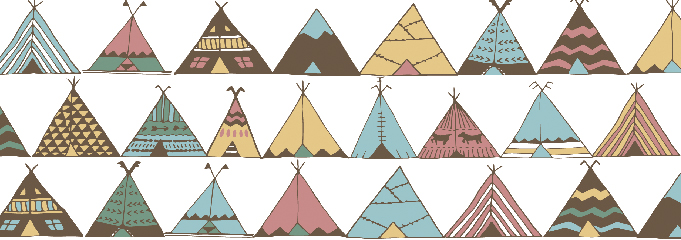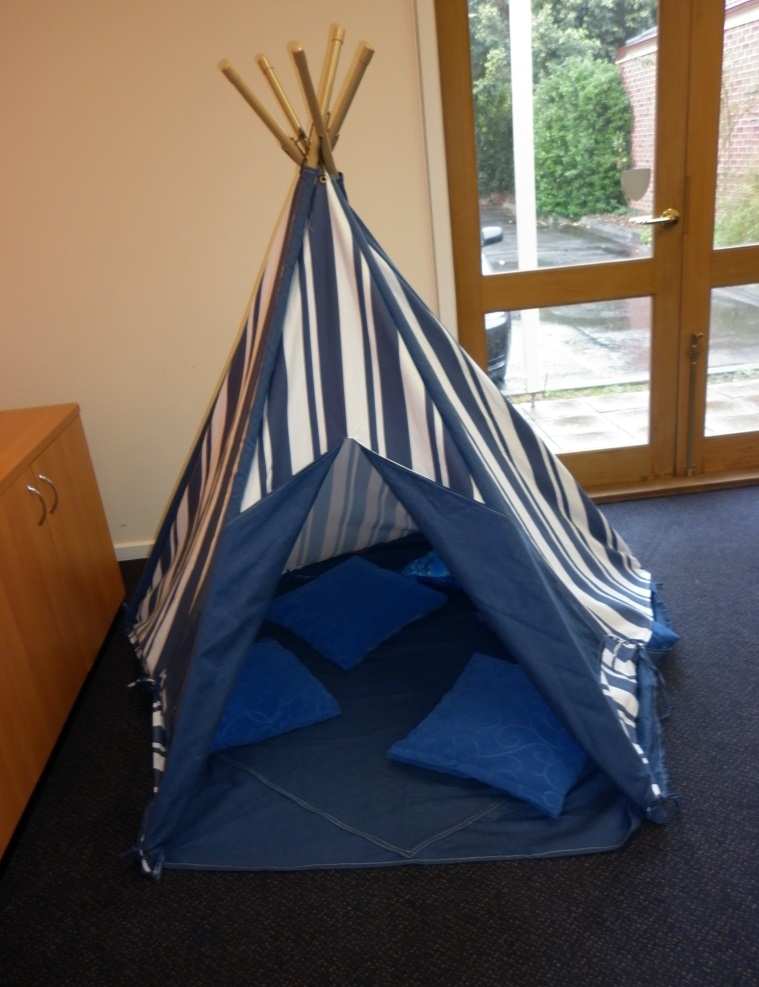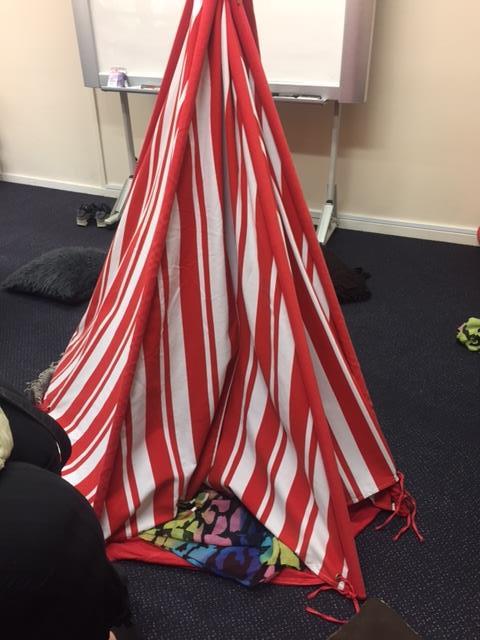
Therapeutic Teepees

Senior Counsellor, Child Trauma Service at the Australian Childhood Foundation.
–
Imagine never feeling safe, never having an escape from a world that is overwhelming, over stimulating and often unresponsive to your core needs. This is the experience for many of the children attending our therapy program at the Child Trauma Service.  As part of supporting children’s recovery, a group built on foundations of Sensorimotor Psychotherapy has been implemented over the past four years (we have written about this group before and you can read about it here) . Often, the children we work with haven’t had much experience with bodily states other than those produced by experiences of trauma, and struggle with regulating their arousal systems and responses. This groups aims to provide children, in conjunction with their carers, opportunities to learn about and experience states of calm and safety, developing an understanding of how they can feel safe in their bodies and know what it means to feel safe at all.
As part of supporting children’s recovery, a group built on foundations of Sensorimotor Psychotherapy has been implemented over the past four years (we have written about this group before and you can read about it here) . Often, the children we work with haven’t had much experience with bodily states other than those produced by experiences of trauma, and struggle with regulating their arousal systems and responses. This groups aims to provide children, in conjunction with their carers, opportunities to learn about and experience states of calm and safety, developing an understanding of how they can feel safe in their bodies and know what it means to feel safe at all.
Whilst much of the group is built around directed activities with specific goals in mind, we have also discovered that other aspects of the group provide equally significant experiences for these children for whom lack of safety is ‘the norm’. One example of these is the use of teepees, which have now become a focal point of safety for children.
Can a teepee really support feelings of safety and support regulation? Can the design of simply having the teepee in the room, a provision of a boundary and escape support a child in healing from trauma? The survival skills our children develop to navigate their complex and unpredictable lives also impacts on their ability to perceive any safety or experience of a boundaries that protect them. In individual and group work the teepee is used and framed by the therapistas a place they can have safety and refuge from the environment which is being experienced as overwhelming. The children in these therapeutic groups have experienced the teepee as a positive and safe space, rather than a ‘time out’ space in response to negative behaviour. This experience of a safe time out space is often a rare one, and provides them with new opportunities to learn how to actively regulate their behaviour in the setting.
As well as the experience within it, we have found that the physical presence of the teepee is important.
 Serving as a reminder of the space they can use when they are dysregulated; where they can go when their bodies tell them they need to, Its visual presence is anchor to that experience of safety. Children learn that they can let people in and have a boundary, that they can say if it’s too dark or too light and negotiate and experiment with what they need for themselves. This is an experience of safety and control that many of our children have never had and requires the support of the therapist or supportive adult to overt what role the teepee is playing for them. From there, they are able to learn to reintegrate themselves back into the room from the safety of the teepee, providing a powerful experience of control for children. When children use the teepee it allows the therapist to make explicit that which is already implicit within their bodies. That is, these children who don’t have the emotional literacy or vocabulary to express themselves, and who have limited regulatory skills, are able to use the teepee to regulate and this in turn allows the space for meaning making with the therapist. These children often can’t say why they’ve gone into the teepee, but are very clear on their need to be there. Children are supported to feel what safety in the teepee feels like in their bodies and to learn to generalise this to the experience of others.
Serving as a reminder of the space they can use when they are dysregulated; where they can go when their bodies tell them they need to, Its visual presence is anchor to that experience of safety. Children learn that they can let people in and have a boundary, that they can say if it’s too dark or too light and negotiate and experiment with what they need for themselves. This is an experience of safety and control that many of our children have never had and requires the support of the therapist or supportive adult to overt what role the teepee is playing for them. From there, they are able to learn to reintegrate themselves back into the room from the safety of the teepee, providing a powerful experience of control for children. When children use the teepee it allows the therapist to make explicit that which is already implicit within their bodies. That is, these children who don’t have the emotional literacy or vocabulary to express themselves, and who have limited regulatory skills, are able to use the teepee to regulate and this in turn allows the space for meaning making with the therapist. These children often can’t say why they’ve gone into the teepee, but are very clear on their need to be there. Children are supported to feel what safety in the teepee feels like in their bodies and to learn to generalise this to the experience of others.
A major benefit of this process, is that we as therapists, are provided with a perfect opportunity to name the experience we observe and support the child to make links between what their bodies are feeling and telling them with any subsequent behaviour. We have found that children are learning through this process to recognise the feelings in their bodies and when they experience dysregulation, they have a place to go. In short, the teepees have become a tool that teaches self-regulation without the members of the group even realising that the process is occurring.
Outcomes for such interventions are difficult to measure, however when working with children, the success of any intervention is evidenced in their behaviour and the uncensored reports of their experience. Perhaps sometimes this evidence has equal value to empirically based interventions. As therapists at the Child Trauma Service, we are constantly guided by the voices and actions of our vulnerable children and when they report the teepee as one of their favorite things from their experience in group (which they do), we know it holds a significant place. When a young girl asked to take the teepee home at the end of one such group, we learnt again the power of offering safety and boundaries for those who have not been afforded this. Imagine now feeling safe for the first time and never wanting to let go of this feeling.
